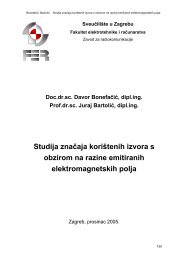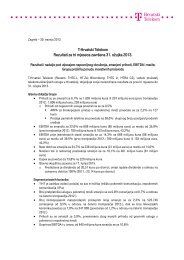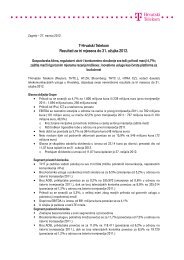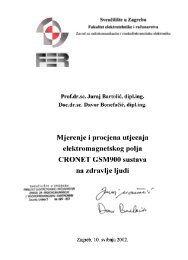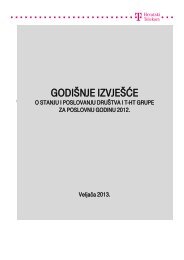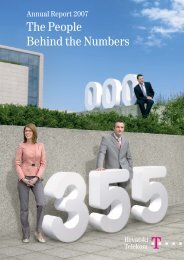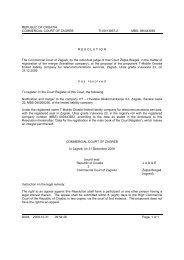Annual Report 2011 - T-Hrvatski Telekom
Annual Report 2011 - T-Hrvatski Telekom
Annual Report 2011 - T-Hrvatski Telekom
You also want an ePaper? Increase the reach of your titles
YUMPU automatically turns print PDFs into web optimized ePapers that Google loves.
79<br />
IAS 39 Financial instruments: Recognition and<br />
measurement, that eliminate the exemption<br />
for contingent consideration, do not apply<br />
to contingent consideration that arose from<br />
business combinations whose acquisition dates<br />
precede the application of IFRS 3 (as revised in<br />
2008).<br />
34 and add disclosure requirements around: The<br />
circumstances likely to affect fair values of financial<br />
instruments and their classification; Transfers of<br />
financial instruments between different levels of<br />
the fair value hierarchy; Changes in classification of<br />
financial assets; and Changes in contingent liabilities<br />
and assets.<br />
Consolidated financial statements<br />
(b) Measurement of non-controlling interests - The<br />
choice of measuring non-controlling interests<br />
at fair value or at the proportionate share of the<br />
acquiree’s net assets applies only to instruments<br />
that represent present ownership interests and<br />
entitle their holders to a proportionate share<br />
of the net assets in the event of liquidation. All<br />
other components of non-controlling interest<br />
are measured at fair value unless another<br />
measurement basis is required by IFRS.<br />
(c) Un-replaced and voluntarily replaced sharebased<br />
payment awards - The application<br />
guidance in IFRS 3 applies to all sharebased<br />
payment transactions that are part of a business<br />
combination, including un-replaced and<br />
voluntarily replaced share-based payment<br />
awards.<br />
IFRS 7 Financial Instruments - Emphasises the<br />
interaction between quantitative and qualitative<br />
disclosures about the nature and extent of risks<br />
associated with financial instruments.<br />
IAS 1 Presentation of Financial Statements - Clarifies<br />
that an entity will present an analysis of other<br />
comprehensive income for each component of equity,<br />
either in the statement of changes in equity or in the<br />
notes to the financial statements.<br />
IAS 27 Consolidated and Separate Financial<br />
Statements - Clarifies that the consequential<br />
amendments from IAS 27 made to IAS 21 The<br />
effect of changes in foreign exchange rates, IAS 28<br />
Investments in associates, and IAS 31 Interests in<br />
joint ventures, apply prospectively for annual periods<br />
beginning on or after 1 July 2009, or earlier when IAS<br />
27 is applied earlier.<br />
IAS 34 Interim Financial <strong>Report</strong>ing - Provide guidance<br />
to illustrate how to apply disclosure principles in IAS<br />
IFRIC 13 Customer Loyalty Programmes - The<br />
meaning of ‘fair value’ is clarified in the context of<br />
measuring award credits under customer loyalty<br />
programmes.<br />
Standards and interpretations issued but not yet<br />
effective<br />
Standards and interpretations that have been issued<br />
and are effective for period after 1 January <strong>2011</strong> are<br />
listed below:<br />
Amendments to IFRS 7 Financial Instruments:<br />
Disclosures on Derecognition (effective for annual<br />
periods beginning on or after 1 July <strong>2011</strong>)<br />
This amendment will promote transparency in the<br />
reporting of transfer transactions and improve users’<br />
understanding of the risk exposures relating to<br />
transfers of financial assets and the effect of those<br />
risks on an entity’s financial position, particularly<br />
those involving securitisation of financial assets. The<br />
amendment affects disclosure only and has no impact<br />
on the Group’s financial position or performance. The<br />
Group plans to adopt this amendment on its effective<br />
date.<br />
Amendments to IFRS 1 First Time Adoption: Fixed<br />
Dates and Hyperinflation (effective for annual periods<br />
beginning on or after 1 July <strong>2011</strong>)<br />
These amendments include two changes to IFRS<br />
1 First-time adoption of IFRS. The first replaces<br />
references to a fixed date of 1 January 2004 with ‘the<br />
date of transition to IFRSs’, thus eliminating the need<br />
for entities adopting IFRSs for the first time to restate<br />
derecognition transactions that occurred before the<br />
date of transition to IFRSs. The second amendment<br />
provides guidance on how an entity should resume<br />
presenting financial statements in accordance<br />
with IFRSs after a period when the entity was



